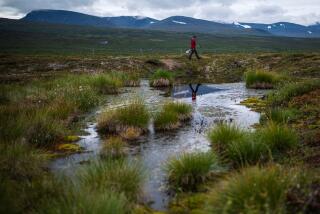New Studies Paint Grim Global Warming Picture
- Share via
WASHINGTON — With diplomats deadlocked over complex efforts to reach an international agreement to curtail global warming, the findings of a 10-year study of the Arctic released Thursday provided new evidence that pollution is playing a significant role in increasing temperatures.
The scientific report followed by a day the U.S. government’s disclosure that so-called greenhouse gas emissions are likely to increase over the next 12 years at a rate nearly 25% greater than previously thought.
Taken together, the studies provide support for those raising the greatest concerns about the climate phenomenon and pressing for the most dramatic measures to counter it.
As a result of the Arctic study, Jonathan Overpeck, one of the project researchers, said, “we have a firmer scientific foundation to say [global warming] is happening. It’s for real. Let’s be careful what we do next.”
“I’m worried about this. I fear what the consequences will be,” added Ray Bradley, head of the geosciences department at the University of Massachusetts and, with Overpeck, one of the authors of the Arctic study, being published today in Science magazine.
With scientists predicting that the level of greenhouse gases in the atmosphere will reach a concentration twice their known highest level ever, Bradley dropped customary scientific caution and said: “Our ecosystem will change. I don’t know how we’ll cope with that.”
The reports were issued as negotiators from the United States, Europe, Japan and Russia, among others, are trying to find their way out of an impasse over what steps they will be willing to take to reduce their emissions of carbon dioxide and other gases widely believed responsible for increasing global temperatures.
Some scientists question whether the increase is taking place and why. But many believe that--unless the richer nations, and increasingly the developing nations, reduce their reliance on oil, gasoline and coal to provide electricity and fuel their transportation networks--the ecological damage will be dramatic. Such extreme weather disruptions as floods and drought, higher sea levels fed by melting glaciers and tropical disease are likely to reach into now-temperate regions, they said.
The negotiators are working against a deadline of Dec. 10 for completing a United Nations-sponsored global warming pact in Kyoto, Japan.
*
Representatives of the European Union and the United States, including Vice President Al Gore and other senior U.S. officials, were unable to bridge a wide gap between their negotiating positions when they met informally in Washington last week. Nor was a high-level meeting in Tokyo last weekend able to make measurable progress.
President Clinton has proposed that by a four-year period beginning in 2008, the developed nations reduce to 1990 levels their emissions of the six major greenhouse gases, which are so named because, once in the atmosphere, they create a greenhouse-like shield that traps the Earth’s heat.
The European Union would include only carbon dioxide and two other gases, and would set a target for 2010 of 15% below the 1990 level.
The report issued Thursday, encompassing the work of Canadian and U.S. scientists, including a team from the National Oceanic and Atmospheric Administration, studied temperatures in the Arctic, collecting data not only from the polar icecap but also from northern Canada, Scandinavia and Siberia.
While some temperature increases noted by the study reflected greater energy from the sun and other natural events, “exponentially increasing atmospheric trace-gas concentrations probably played an increasingly dominant role,” the team wrote in Science.
The researchers used ice core samples, changes in the size of rings in slices taken from trees and studies of pond sediment to trace temperature changes over 4 centuries.
“In the Arctic, we’re seeing a dramatic response to greenhouse warming after the 1950s,” said Overpeck, of NOAA’s National Geophysical Data Center in Boulder, Colo.






